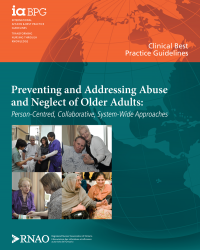
Case study #1 - Toronto Public Health

Toronto Public Health (TPH) is a Best Practice Spotlight Organization® (BPSO®) in Toronto, Canada. This organization has implemented several RNAO best practice guidelines, including Woman Abuse: Screening, Identification and Initial Response (2005) and Preventing and Addressing Abuse and Neglect of Older Adults (2014).
Some practice recommendations in these guidelines focused on the individual person/patient level and did not always align with TPHs population health approach.
To adapt recommendations to the public health context, the change team completed a literature review to explore definitions and adapt strategies to align with the model of care delivery and health promotion philosophy.
Another approach TPH took was to pilot test recommendations from BPGs within one small program team. The team would then evaluate the implementation until successful (consistent with the Plan-Do-Study-Act approach). Once successful, the intervention was scaled up within the organization to other programs and teams (Timmings et al., 2018).
Case study#2 - DongZhiMen Hospital

DongZhiMen Hospital, a BPSO in Beijing China, was motivated to reform care delivery through the use of evidence-based practice guidelines. While best practice recommendations provided general guidance, they identified a need to translate these statements into detailed instructions and parameters that were tailored to their specific hospital context.
To adapt statements to their context, they translated the guideline and then a multidisciplinary team worked through the initial steps of the Knowledge-to-Action framework. This involved carefully reviewing the evidence to thoroughly understand the intent of the recommendations, conducting a comprehensive gap analysis, and interviewing stakeholders to identify facilitators and barriers to the use of the guideline. Using this information, the team was able to create specific, clinical nursing practice standards that were relevant to the context and derived from the recommendations (Hailing & Runxi, 2018).
